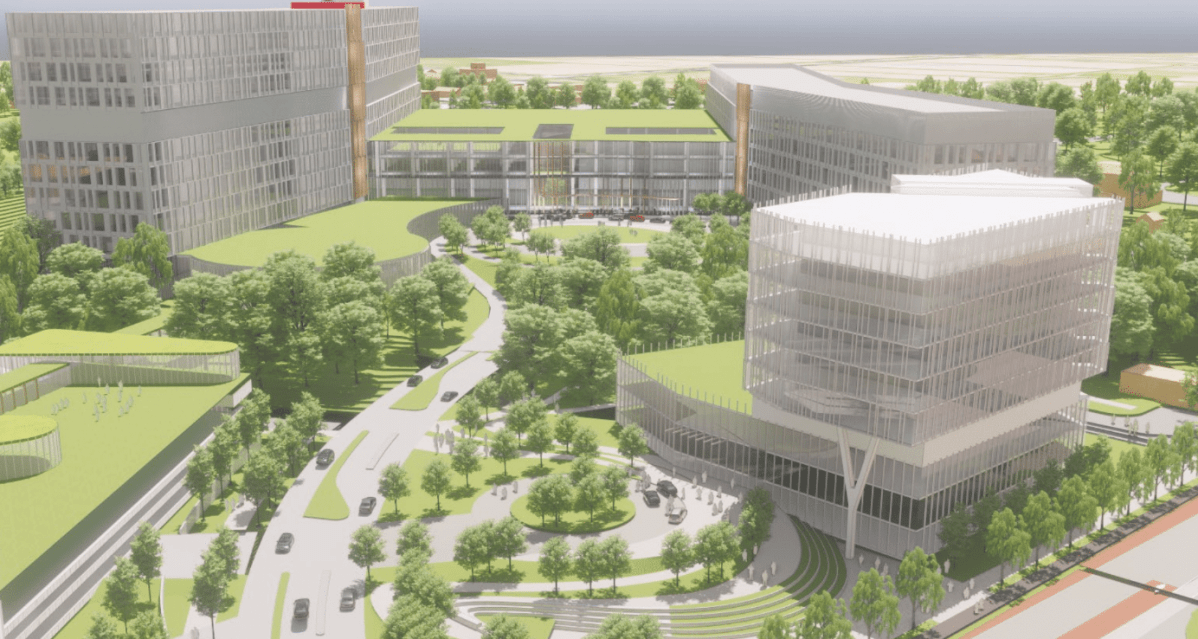The Ottawa Hospital on Tuesday morning showed a first look at plans for its new Civic campus, a long-awaited $2.8-billion project with designs influenced by lessons from the COVID-19 pandemic.

The new site, set to open to the public in 2028, will be built just down Carling Avenue from the existing Civic campus, coming to a head at Preston Street and Prince of Wales Drive.
The 2.5-million-square-foot facility’s main building will see two towers of 11 storeys and seven storeys connected by a central atrium. Emergency care will be one floor below grade, while acute care will occupy the west wing and critical care beds will be in the eastern-facing tower.
Additional buildings with clinical, educational and research functions will be built on the lower portion of the campus.
The campus will be integrated into the nearby Experimental Farm and Dow’s Lake areas, with access via numerous roadways and a covered walkway connecting the hospital to the forthcoming light-rail transit station as part of Stage 2 LRT.
The main access to the site from Carling Avenue will see an underground entrance take patients directly to emergency care and a cul-de-sac approach for non-emergency visits. Ambulance access would be primarily from the rear of the building.
Traffic impacts from the new Civic campus will be studied and presented to the city for consultation this coming summer.
The Ottawa Hospital’s CEO Cameron Love, who presented the Civic campus vision to the city’s finance and economic development committee on Tuesday morning, told Global News that the COVID-19 pandemic, which continues to stress health-care capacity across the nation’s capital, has informed the design of the next-generation facility.

Get weekly health news
All of the new Civic campus’s beds will be in fully private rooms, with even bathrooms set aside for single patients. Avoiding shared touch points and other spaces can greatly reduce transmission risks between patients and their caregivers, Love said.

Not including the Heart Institute, the new facility will have 640 beds in total, compared with 460 existing beds at the current Civic down the road.
“Having that bed capacity increased, in addition to them all being private rooms, would be a significant difference in terms of the mechanism by which we can manage in another pandemic environment,” Love said.
The layout of the hospital itself is being design to implement infection control protocols that minimize the impact to operations and avoid compromising patient wellness.
Entrances to the hospital can be designed to easily implement screening protocols in the event of a pandemic, and the intensive care unit can be built from day one with surge capacity to double the number of available beds without squeezing multiple ICU patients into one room, Love said.
The new Civic campus is also being designed to adapt patient care for years of technological advancements.
At a minimum, this means devices like digital charts in each patient’s room to allow physicians, nurses, patients and their family to access the latest test results and prognoses as they’re available.
But it also means translating those technologies beyond the walls of the Civic itself, with digital care to monitor outpatients after they’ve left the hospital. Connections like these can help physicians determine whether a patient needs to be readmitted to the hospital or even if they can be treated from home, Love said.
And while The Ottawa Hospital is already making use of some robotics in surgical procedures today, Love only sees those applications growing over the coming decades. While the shape of future health-care innovations is unknown, the new Civic campus is being built with the “flexibility” to accommodate future technologies, he said.
“The robotics, the automation and artificial intelligence are going to inform and transform health care, probably for the next 25 years if not longer.”

The massive Civic campus project is just one phase of a multi-decade plan that will see ripple effects on health-care institutions across Ottawa.
The Riverside Campus, for example, will see a new long-term care centre built in concert with the new Civic. Love said the hospital is taking this move in recognition that many patients with chronic conditions such as heart disease or diabetes require post-acute care and already have to visit clinics at the Riverside to treat these conditions on an ongoing basis.
Similarly, as the new Civic comes online, the old campus will be repurposed for post-acute and community-based care. Between the old Civic, the new Civic and the Royal Ottawa Mental Health Centre down the road, Love said during Tuesday’s meeting that he imagines Carling Avenue becoming something of a “hospital row” akin to University Avenue in Toronto.
Construction on early works such as a parking garage on the site could begin as soon as next year, with fulsome development on the project starting in 2024.
The Ottawa Hospital has submitted the initial designs as part of its Stage 2 proposal to the Ministry of Health and is expecting sign-off on the project this summer.
The Ontario government is covering $2.1 billion of the costs. A portion of the remaining shortfall is expected to be covered by a $400-million fundraising campaign, and Love said he expects revenues such as parking, retail and food arrangements to cover off the remaining costs.












Comments